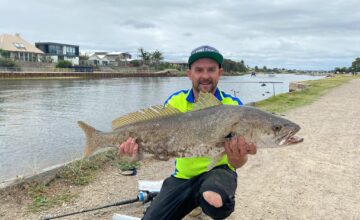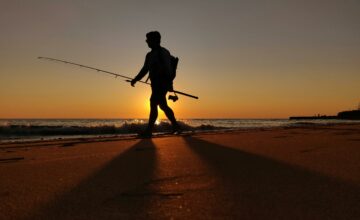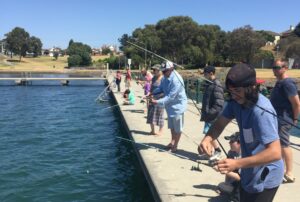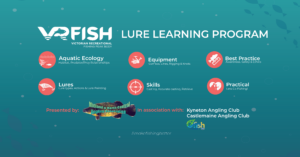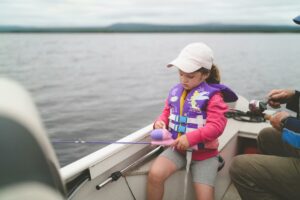June 30, 2017
Written by Lauren Veale, Nature Glenelg Trust
Since my previous article in the summer 2015 edition of Fishing Lines, our Citizen Science Project has continued to provide new insights into Victorian mulloway populations. Funded by Recreational Fishing License Fees, the success of this research project has been attributed to the support and involvement of Victorian recreational anglers. This partnership between fishers and scientists continues to enhance our knowledge on the life history of one of Victoria’s most sought after species.
Since the program began in late 2014, over 120 anglers have collectively donated almost 500 mulloway frames to the research. The highest number of frames has come from the Barwon and Glenelg Rivers, while other key areas include, the Hopkins River, Patterson River and, Western Port Bay.
Donated mulloway range in total length from 51 to 150 centimetres, and have been aged between three and 25 years. The majority of mulloway caught from Victorian estuaries have been juveniles, below the approximate length at maturity (85 cm). This highlights the importance of estuarine systems as key nursery areas. It’s therefore presumed that mulloway recruit into estuaries early in life, where they remain until reaching maturity. The older life stages of Victorian mulloway remain largely unknown, with few anglers targeting the species in the open ocean.
Length and age data collected over the past three years has provided important information on population structures. In 2014 when the project began, the fishery was largely dominated by mulloway aged at three plus years. This cohort of fish remained prevalent throughout 2015 (four plus years) and 2016 (five plus years), suggesting the Victorian mulloway fishery has largely been supported by one dominant cohort of fish over the past three years.
There is strong evidence to suggest that mulloway recruitment is positively influenced by increased freshwater flows. It is therefore no surprise that this dominant cohort is the progeny of spawning in spring-summer 2010/11 when significant flooding occurred across catchments in southeast South Australia (SA) and Victoria.
In addition to providing important data on length and age structures, frame donations have provided the necessary samples for us to undertake sophisticated genetic analyses that allow us to better understand Victorian stock structures.
Using powerful genomic sequencing, we have assessed the spatial extent and frequency of gene exchange and the recruitment migration between mulloway stocks in Victoria and interstate. Over 300 tissue samples representing 14 locations (from Victoria, SA and New South Wales (NSW)) were used for genomic analysis.

Map showing the location of sampling sites and the three genetically distinct populations: 1) far west SA (blue); 2) southeast SA/ Victoria (green) and; 3) NSW (red).
The analyses revealed that mulloway, occurring between the Coorong in SA and Western Port Bay, form a single randomly mating stock. This is consistent with acoustic tagging work by the Arthur Rylah Institute that showed connectivity between the Coorong and the Glenelg River.

Age frequencies of mulloway donated by mainly recreational anglers from the various regions in 2014 (Aug-Dec), 2015 (Jan-Dec) and 2016 (Jan Feb).
We detected weak but significant genetic differentiation between far west SA, Victorian/southeast SA and NSW mulloway stocks, suggesting that gene flow is limited between these regions. The potential genetic isolation of Victorian/southeast SA and NSW populations is possibly due to their separation by the wellrecognised biogeographic divide in eastern Victoria. Here, the contemporary physical conditions of Bass Strait, associated with the Bassian Isthmus, present a continuing barrier to the dispersal for many marine species, including fish and invertebrates. However, further intermediate geographic sampling of mulloway stocks between Western Port Bay and Eden is required to determine if the stocks either side of Bass Strait are truly isolated.
The Mulloway Citizen Science Project has provided critical information on age structures and growth rates, the first estimates of length/age at maturity for Victorian mulloway and, has recently redefined stock boundaries through genomics. Equally important, is the opportunity of engaging with anglers and allowing them to contribute to increased knowledge and ultimately improved species management. A huge thank you to all those anglers involved in the research program.
If you are passionate about catching mulloway, please get involved in the project by becoming a citizen scientist. We are particularly keen to hear from anglers that catch mulloway in Victorian marine waters to help address the current knowledge gap surrounding the older life stages.
For more information, contact Lauren Veale at the Nature Glenelg Trust by E: [email protected] or M: 0439 034 390. You can also join our Facebook Page for a list of drop-off points where you can donate your frames.



